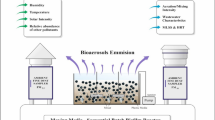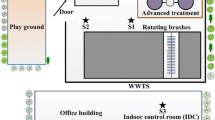Abstract
Bioaerosol concentration was measured in wastewater treatment units in south of Tehran, the largest wastewater treatment plant in the Middle East. Active sampling was carried out around four operational units and a point as background. The results showed that the aeration tank with an average of 1016 CFU/m3 in winter and 1973 CFU/m3 in summer had the greatest effect on emission of bacterial bioaerosols. In addition, primary treatment had the highest impact on fungal emission. Among the bacteria, Micrococcus spp. showed the widest emission in the winter, and Bacillus spp. was dominant in summer. Furthermore, fungi such as Penicillium spp. and Cladosporium spp. were the dominant types in the seasons. Overall, significant relationship was observed between meteorological parameters and the concentration of bacterial and fungal aerosols.


Similar content being viewed by others
References
Abdel Hameed A, Khoder M et al (2009) "Diurnal distribution of airborne bacteria and fungi in the atmosphere of Helwan area, Egypt." Sci Total Environ 407(24):6217–6222
Basart S, Pay M et al. (2012) Aerosols in the CALIOPE air quality modelling system: evaluation and analysis of PM levels, optical depths and chemical composition over Europe. Atmos Chem Phys 12(7)
Brandi G, Sisti M et al (2000) Evaluation of the environmental impact of microbial aerosols generated by wastewater treatment plants utilizing different aeration systems. J Appl Microbiol 88(5):845–852
Bredholt H, Fjærvik E et al (2008) Actinomycetes from sediments in the Trondheim fjord, Norway: diversity and biological activity. Mar Drugs 6(1):12–24
Breza-Boruta B, Paluszak Z (2007) Influence of water treatment plant on microbiological composition of air bioaerosol. Pol J Environ Stud 16(5)
Burkowska A, Kalwasińska A et al (2012) Airborne mesophilic bacteria at the Ciechocinek health resort. Pol J Environ Stud 21(2):307–312
Carducci A, Tozzi E et al (2000) Assessing airborne biological hazard from urban wastewater treatment. Water Res 34(4):1173–1178
Cox CS, Wathes CM (2010) Bioaerosols handbook, crc press.
Fang Z, Ouyang Z et al (2005) Culturable airborne fungi in outdoor environments in Beijing, China. Sci Total Environ 350(1):47–58
Fang Z, Ouyang Z et al (2008) Concentration and size distribution of culturable airborne microorganisms in outdoor environments in Beijing, China. Aerosol Sci Technol 42(5):325–334
Faridi S, Hassanvand MS et al (2014) "Indoor/outdoor relationships of bioaerosol concentrations in a retirement home and a school dormitory." Environ Sci Pollut Res 22(11):8190–8200
Fernando NL, Fedorak PM (2005) Changes at an activated sludge sewage treatment plant alter the numbers of airborne aerobic microorganisms. Water Res 39(19):4597–4608
Filipkowska Z, Janczukowicz W et al (2000) Microbiological air pollution in the surroundings of the wastewater treatment plant with activated-sludge tanks aerated by horizontal rotors. Pol J Environ Stud 9(4):273–280
Grisoli P, Rodolfi M et al (2009) Assessment of airborne microorganism contamination in an industrial area characterized by an open composting facility and a wastewater treatment plant. Environ Res 109(2):135–142
Heinonen-Tanski H, Reponen T et al (2009) Airborne enteric coliphages and bacteria in sewage treatment plants. Water Res 43(9):2558–2566
Hoseini M, Jabbari H et al (2012) Concentration and distribution characteristics of airborne fungi in indoor and outdoor air of Tehran subway stations. Aerobiologia 29(3):355–363
Karra S, Katsivela E (2007) Microorganisms in bioaerosol emissions from wastewater treatment plants during summer at a Mediterranean site. Water Res 41(6):1355–1365
Kim KY, Kim CN (2007) "Airborne microbiological characteristics in public buildings of Korea." Build Environ 42(5):2188–2196
Kim KY, Kim YS et al (2009) Distribution characteristics of airborne bacteria and fungi in the general hospitals of Korea. Ind Health 48(2):236–243
Korzeniewska E (2011a) Emission of bacteria and fungi in the air from wastewater treatment plants—a review. Front Biosci 3:393–407
Korzeniewska E (2011b) Emission of bacteria and fungi in the air from wastewater treatment plants—a review. Front Biosci S3:393–407
Kruczalak K, Olanczuk-Neyman K (2004) Microorganisms in the air over wastewater treatment plants. Pol J Environ Stud 13(5):537–542
Krzysztofik B (1992) [Microbiology of air]. Inzynieria Srodowiska (Poland)
Laitinen S, Kangas J et al (1994) Workers' exposure to airborne bacteria and endotoxins at industrial wastewater treatment plants. Am Ind Hyg Assoc 55(11):1055–1060
Lee J-H, Jo W-K (2006) "Characteristics of indoor and outdoor bioaerosols at Korean high-rise apartment buildings." Environ Res 101(1):11–17
Małecka-Adamowicz M, Kaczanowska J et al (2007) The impact of a landfill site in Żółwin—Wypaleniska on the bicrobiological quality of the air. Pol J Environ Stud 16(1)
Mentese S, Rad AY et al (2012) "Seasonal and spatial variations of bioaerosols in indoor urban environments, Ankara, Turkey." Indoor Built Environ 21(6):797–810
Michałkiewicz M, Pruss A et al (2011) Microbiological air monitoring around municipal wastewater treatment plants. Pol J Environ Stud 20(5)
Oppliger A, Hilfiker S et al (2005) Influence of seasons and sampling strategy on assessment of bioaerosols in sewage treatment plants in Switzerland. Ann Occup Hyg 49(5):393–400
Papke RT, Ward DM (2004) The importance of physical isolation to microbial diversification. FEMS Microbiol Ecol 48(3):293–303
Pascual L, Pérez-Luz S et al (2003) Bioaerosol emission from wastewater treatment plants. Aerobiologia 19(3–4):261–270
Prazmo Z, Krysinska-Traczyk E et al (2003) Exposure to bioaerosols in a municipal sewage treatment plant. Ann Agric Environ Med 10(2):241–248
Recer GM, Browne ML et al (2001) Ambient air levels of Aspergillus fumigatus and thermophilic actinomycetes in a residential neighborhood near a yard-waste composting facility. Aerobiologia 17(2):99–108
Sánchez-Monedero M, Aguilar M et al (2008) Effect of the aeration system on the levels of airborne microorganisms generated at wastewater treatment plants. Water Res 42(14):3739–3744
Scaltriti S, Cencetti S et al (2007) "Risk factors for particulate and microbial contamination of air in operating theatres." J Hosp Infect 66(4):320–326
Thorn J, Beijer L et al (2002) Measurement strategies for the determination of airborne bacterial endotoxin in sewage treatment plants. Ann Occup Hyg 46(6):549–554
Wang Y-F, Wang C-H et al (2010) "Size and seasonal distributions of airborne bioaerosols in commuting trains." Atmos Environ 44(35):4331–4338
Wlazło A, Pastuszka J et al (2001) Assessment of workers' exposure to airborne bacteria at a small wastewater treatment plant. Med Pr 53(2):109–114
Acknowledgments
The authors are grateful to the south of Tehran wastewater treatment plan for providing us with the sampling locations. This work was funded by the Institute for Environmental Research (IER) of Tehran University of Medical Sciences (grant number 90-03-46-21153).
Author information
Authors and Affiliations
Corresponding author
Additional information
Responsible editor: Philippe Garrigues
Sadegh Niazi and Mohammad Sadegh Hassanvand are coequal first author.
Rights and permissions
About this article
Cite this article
Niazi, S., Hassanvand, M.S., Mahvi, A.H. et al. Assessment of bioaerosol contamination (bacteria and fungi) in the largest urban wastewater treatment plant in the Middle East. Environ Sci Pollut Res 22, 16014–16021 (2015). https://doi.org/10.1007/s11356-015-4793-z
Received:
Accepted:
Published:
Issue Date:
DOI: https://doi.org/10.1007/s11356-015-4793-z




